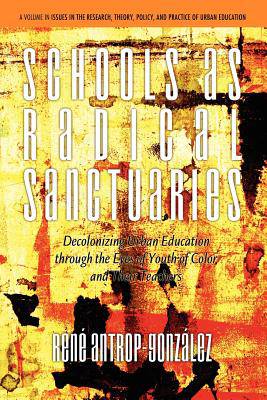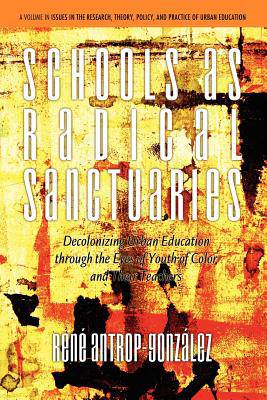
- Retrait gratuit dans votre magasin Club
- 7.000.000 titres dans notre catalogue
- Payer en toute sécurité
- Toujours un magasin près de chez vous
- Retrait gratuit dans votre magasin Club
- 7.000.0000 titres dans notre catalogue
- Payer en toute sécurité
- Toujours un magasin près de chez vous
Schools as Radical Sanctuaries
Decolonizing Urban Education Through the Eyes of Youth of Color and Their Teachers
Rene Antrop-GonzalezDescription
Large, comprehensive urban high schools were designed and constructed with the belief that they could meet the needs of all its students, academic and otherwise. By and large, however, these schools have only done a good job of sorting students for specific jobs in a society based on capitalism and White supremacy. Consequently, students schooled in these large institutions are often sorted depending on how they are situated and/or perceived by institutional agents (i.e. teachers, administrators, guidance counselors, and other staff) along racial/ethnic, class, gender, sexual orientation, and ability lines. The overall result of such structurally and culturally-based discriminatory practices has led to astronomically horrendous dropout/pushout rates among urban youth, particularly those of color who live in poverty.
However, in such a sea of despair, there exist islands of hope and miracles. These islands of hope and miracles are constituted of small high schools that have become sanctuaries for their students, their families, and communities of color. Moreover, not only do these school sanctuaries exist, but they have the potential to serve as inspirations to communities that are looking to the small schools initiative as a possible solution to the widespread failure of large, comprehensive high schools to serve their needs. Although much recent small schools research discusses the benefits of smallness, very little of this research demonstrates or acknowledges the various ways in which communities have created small schools that have established the necessary conditions to make them sustainable, culturally relevant, and linked to social justice while greatly impacting the improved academic achievement of their students. Therefore, the focus of this book is to advance the school as radical sanctuary concept as described through the history, curricula, and experiences of urban youth and their teachers in two small urban high schools. This book is important for those educationists who wish to deepen their understanding of small school reform and its implications for urban education.
Spécifications
Parties prenantes
- Auteur(s) :
- Editeur:
Contenu
- Nombre de pages :
- 132
- Langue:
- Anglais
- Collection :
Caractéristiques
- EAN:
- 9781617355905
- Date de parution :
- 04-10-11
- Format:
- Livre broché
- Format numérique:
- Trade paperback (VS)
- Dimensions :
- 156 mm x 234 mm
- Poids :
- 195 g

Les avis
Nous publions uniquement les avis qui respectent les conditions requises. Consultez nos conditions pour les avis.






